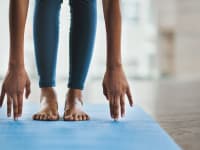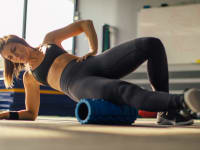Can red light therapy help you recover post-workout?
What to know about this experimental treatment
Products are chosen independently by our editors. Purchases made through our links may earn us a commission.
Red light therapy goes by many names—biostimulation, photobiomodulation (PBM), low level light therapy (LLLT), and cold laser therapy, to name a few—and has even more purported benefits for your body. Topical exposure to the longer wavelengths of red light is thought to help ease skin conditions like psoriasis and acne. But what about benefits for the rest of the body? Some research suggests that red light therapy could help improve muscle recovery and athletic performance. Here’s what you need to know before you add it to your fitness routine.
What is red light therapy?
Red light therapy, commonly referred to as RLT, exposes areas of your body to low levels of red or near-infrared light with the aim to help improve the energy production of your cells. With better energy production, the body's cells may be able to work more efficiently to increase blood circulation, stimulate collagen production, and reduce inflammation. The red light purportedly works by stimulating the cells’ mitochondria, which are their energy-producing centers, explains Sarah Anderson, a nurse practitioner at Peak Integrative Wellness.
RLT devices can be large or small boxes you place near your skin, miniature wands for your face, or sauna blankets, which expose your entire body to the light. Most suggest starting slow with one or two minutes' exposure and working your way up to 10 to 20 minutes, five times per week, to induce results.
RLT is commonly used to treat skin cancer, psoriasis, acne, and warts, though it has many other possible benefits such as healing wounds, relieving muscle and joint pain, and even boosting athletic performance.
Can red light therapy benefit your muscles?
The key result from RLT that may be most interesting to gym rats and athletes is its effect on inflammation. “Red light therapy stimulates the cells to work, to grow, and to heal,” Anderson says. “It reduces inflammation, which is what causes people to be sore after a workout; it increases blood flow and circulation, so you get more blood flow to the muscle that you're trying to work; and it stimulates collagen, which is like the framework of all cells of our body, in our skin and our muscles and our tendons or joints.”
Is red light therapy safe?
Unlike ultraviolet (UV) rays, which are known to damage the skin and potentially cause cancer, red and infrared light is nontoxic and won’t harm the skin and body. You don’t need to lather up the sunscreen before using red light, though you may want to protect your eyes for comfort.
Red light therapy is considered safe for most, though you should consult with your doctor before trying it to see if it’s right for you. Though there are no documented risks, holding the light too close to your body could be irritating for those with sensitive skin.
The main downside of red light therapy is that research is limited, so while it’s not believed to be dangerous, its benefits aren’t always promised. It's also pricey, with in-office visits potentially costing $100 or more each.
How can you get the benefits of red light therapy at home?

You can get red light at home with the right equipment.
Though you can seek red light treatments from a professional, getting $100 sessions up to five days a week could prove a greater financial commitment than you're willing to make. Plenty of devices allow you to access RLT at home for a one-time investment—just make sure to look for one that emits lightwaves that measure 600 to 900 nanometers (nm) which is the spectrum for red to infrared light. The Joovv Go 2.0 is a portable handheld device that emits 660nm or 850nm of light and, anecdotally, reviewers say they feel like they recover more quickly and are in less pain after using it. At $545, it’s an investment, but if you’re serious about giving RLT a chance, you’ll get your money’s worth.
You could also try a red light wrap, which you can wear around various body parts for a hands-free red light experience. The Lifepro red light therapy belt, $189, uses 660nm and 850nm light frequencies, and reviewers say it’s a cinch to apply almost anywhere on the body.


